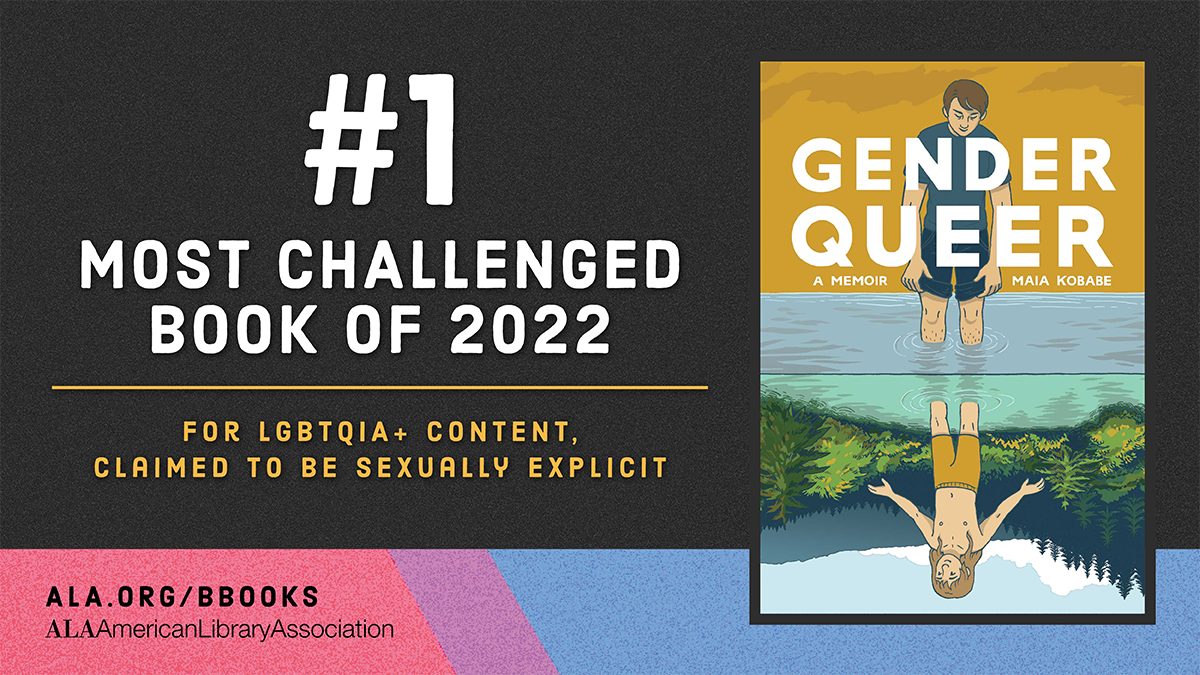You might think the most banned book in the country right now would be violent, full of curse words, or morally reprehensible in some way. But no — the subject of the most book challenges per the American Library Association is Gender Queer, a graphic novel-slash-memoir about a young person’s coming of age.
Author Maia Kobabe published eir story in 2019, about realizing e was nonbinary (Kobabe uses e/em/eir pronouns). It’s about growing up in Northern California with hippie parents and slowly understanding that e, while assigned female at birth (or AFAB), didn’t feel at all like a girl. Kobabe, now 34, writes and draws about the disappointment of getting eir period at 11; about refusing to wear shorts for years so e could avoid shaving; about experimenting with chest binding and fantasizing about having a male twin.
“In high school I began to theorize that I had been born with two half souls — one female and one male,” Kobabe writes. “I invented and named a lost male twin who had always felt like he should be a girl.”
From July 2021 to Dec. 2022, Gender Queer was banned in 56 school districts, per PEN America. It was the subject of 151 challenges in 2022, according to the ALA. The chief complaints against the book are that it contains graphic depictions of sex.
That’s not wrong — Kobabe portrays stuffing eir pants with a sock and rubbing eir crotch over jeans while picturing two naked men kissing. Gender Queer also features a section about Kobabe’s first romantic relationship with a woman, in which eir girlfriend performs oral sex on a strap-on.
It’s this latter image that gets the book labeled as pornographic, even though the drawings are clearly cartoon-like. Kobabe has defended the decision to include this sequence, explaining that eir aims were educational: “I wrote this book as a letter to my parents and my extended family, hoping that they would finally understand what I was trying to say and really know me at a deeper level,” e told PEN America. Sexuality, Kobabe says, is a vital part of eir gender identity. Along with being nonbinary, e identifies as queer and bisexual.
It’s important to note that nobody thinks Gender Queer belongs in the hands of elementary school students. It’s a Young Adult book, which is generally considered appropriate for readers starting at the age of 14. By that time, the vast majority of kids will have started thinking critically about gender and sexuality. Many have already began dating and have had to consider what they’re comfortable doing with their bodies.
Which is why I think one of Gender Queer’s greatest strengths is in offering a positive example around consent. The sex in Gender Queer isn’t particularly steamy, but it is instructive on how to maintain one’s boundaries. When e meets the girlfriend, identified only as Candidate Z, for their first date, e explains that e “hasn’t kissed anyone since elementary school” and is not comfortable with penetration. Later, when Candidate Z confesses that she’s developing feelings for Kobabe, e is honest that e isn’t ready for a relationship. “I’m really sorry but I need to stop dating for a while,” Kobabe says. “I have too much gender stuff to figure out first.”
It’s these moments that are ultimately more important than the details of Kobabe’s sexual encounters. The memoir isn’t just about gender nonconformity — it’s about self-protection, self-advocacy and self-acceptance. E ultimately finds eirself through personal style, through work and more authentic family relationships. “I never have to get married,” Kobabe realizes late in the story. “I never have to date anyone. I don’t even have to care about sex.”
Tough to argue that a book that contains these words is strictly pornographic. And as is often the case with titles that piss off parents due to controversial passages, many school boards, in places like Pennsylvania, Texas and Oregon, have voted to keep Gender Queer on high school library shelves after simply reading it cover to cover.
.




